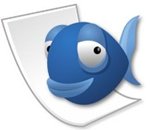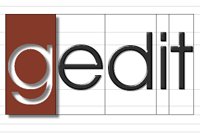We know you love OpenOffice.org, as this software provides everything you need to create professional documents, spreadsheets, images and more – all for free, because it’s open source. But, other programs exist that can live peacefully beside your OpenOffice.org environment. The graphic and text viewers and editors listed below also are open source or licensed under a GNU General Public License.
Although many open source software programs are designed only for open source operating systems (OS), most developers know it will take years for everyone to switch to Linux or Unix OS. And, they also know that not everyone is keen on using Linux or Unix. So, they’ve developed software that is cross-platform. This is a good thing, as most people are willing to try something that’s free…and that’s the foundation for the list of ten-plus (actually twelve) open source graphic and text viewer or editing software programs listed below:
The programs below are listed in alphabetical order.
 Amaya: You can use Amaya to create and update documents directly on the Web. This is an open source software project hosted by W3C (World Wide Web Consortium) and jointly developed by W3C and WAM (Web, Adaptation and Multimedia), so you can trust the software. It supports HTML 4.01, XHTML 1.0, XHTML Basic, XHTML 1.1, HTTP 1.1, MathML 2.0, many CSS feathres and SVG.
Amaya: You can use Amaya to create and update documents directly on the Web. This is an open source software project hosted by W3C (World Wide Web Consortium) and jointly developed by W3C and WAM (Web, Adaptation and Multimedia), so you can trust the software. It supports HTML 4.01, XHTML 1.0, XHTML Basic, XHTML 1.1, HTTP 1.1, MathML 2.0, many CSS feathres and SVG. Abiword: AbiWord is a free word processing program similar to Microsoft Word. It is suitable for a wide variety of word processing tasks. AbiWord is part of a larger project known as AbiSource, which was started by the SourceGear Corporation. The goal of the project was the development of a cross-platform, open source office suite beginning with AbiWord, the project’s word processor. Their goal is to become truly cross-platform camaptible. Currently they run on most UNIX systems, Windows 95 and later and QNX Neutrino 6.2. They also have a MacOS X native port available.
Abiword: AbiWord is a free word processing program similar to Microsoft Word. It is suitable for a wide variety of word processing tasks. AbiWord is part of a larger project known as AbiSource, which was started by the SourceGear Corporation. The goal of the project was the development of a cross-platform, open source office suite beginning with AbiWord, the project’s word processor. Their goal is to become truly cross-platform camaptible. Currently they run on most UNIX systems, Windows 95 and later and QNX Neutrino 6.2. They also have a MacOS X native port available. Blender: Blender is the free open source 3D content creation suite, available for all major operating systems under the GNU General Public License. It operates under Windows 2000, XP or Vista, Mac OS X 10.2 and later, Linux 2.2.5 i386 or Linux 2.3.2 PPC, FreeBSD 6.2 i386, Iris 6.5 mips3 and Solaris 2.8 sparc. Although Blender is avaliable cross platform, it utilizes OpenGL for drawing the entire interface. That means you best use a graphics card and drivers that conform to the OpenGL specifications. Outside this issue, the software is amazing for character rigging and animation.
Blender: Blender is the free open source 3D content creation suite, available for all major operating systems under the GNU General Public License. It operates under Windows 2000, XP or Vista, Mac OS X 10.2 and later, Linux 2.2.5 i386 or Linux 2.3.2 PPC, FreeBSD 6.2 i386, Iris 6.5 mips3 and Solaris 2.8 sparc. Although Blender is avaliable cross platform, it utilizes OpenGL for drawing the entire interface. That means you best use a graphics card and drivers that conform to the OpenGL specifications. Outside this issue, the software is amazing for character rigging and animation. Bluefish: Bluefish is a powerful editor targeted towards programmers and webdesigners, with many options to write websites, scripts and programming code. Bluefish supports many programming and markup languages, and it focuses on editing dynamic and interactive websites. Bluefish uses 30-45 percent of memory compared to other popular web development editors. Bluefish is lightweight, fast, supports a multiple-document interface and have an unlimited undo/redo functionality.It supplies a compliance with the gnome and KDE user interface guidelines where possible.
Bluefish: Bluefish is a powerful editor targeted towards programmers and webdesigners, with many options to write websites, scripts and programming code. Bluefish supports many programming and markup languages, and it focuses on editing dynamic and interactive websites. Bluefish uses 30-45 percent of memory compared to other popular web development editors. Bluefish is lightweight, fast, supports a multiple-document interface and have an unlimited undo/redo functionality.It supplies a compliance with the gnome and KDE user interface guidelines where possible. F-Spot: F-Spot is a full-featured personal photo management application for the GNOME desktop. This software simplifies digital photography by providing intuitive tools to help you share, touch-up, find and organize your images. F-Spot is free, open source software that supports 16 common files types, including JPEG, GIF, TIFF, RAW and more.
F-Spot: F-Spot is a full-featured personal photo management application for the GNOME desktop. This software simplifies digital photography by providing intuitive tools to help you share, touch-up, find and organize your images. F-Spot is free, open source software that supports 16 common files types, including JPEG, GIF, TIFF, RAW and more. gedit: gedit is the official text editor of the GNOME desktop environment. gedit features also a flexible plugin system which can be used to dynamically add new advanced features to gedit itself. Users can enjoy a Wiki as well as full support for internationlized text (UTF-8), the ability to edit files from remote locations and a complete online user manual. gedit is released under the GNU General Public License (GPL).
gedit: gedit is the official text editor of the GNOME desktop environment. gedit features also a flexible plugin system which can be used to dynamically add new advanced features to gedit itself. Users can enjoy a Wiki as well as full support for internationlized text (UTF-8), the ability to edit files from remote locations and a complete online user manual. gedit is released under the GNU General Public License (GPL). gimp: GIMP is an acronym for GNU Image Manipulation Program. It is a freely distributed program for such tasks as photo retouching, image composition and image authoring. It can be used as a simple paint program, an expert quality photo retouching program, an online batch processing system, a mass production image renderer, an image format converter and more.
gimp: GIMP is an acronym for GNU Image Manipulation Program. It is a freely distributed program for such tasks as photo retouching, image composition and image authoring. It can be used as a simple paint program, an expert quality photo retouching program, an online batch processing system, a mass production image renderer, an image format converter and more. GNU Paint: GNU Paint is a simple, easy-to-use paint program for GNOME, the GNU Desktop. Gpaint is part of the GNU Project. Written by Andy Tai, Gpaint is licensed under the GNU GPL, version 2 or later. Use this software for drawing, editing multiple images and to alter images with freehand or shapes. GNU Paint offers print support using gnome-print and a modern, easy-to-use interface with tool and color palettes.
GNU Paint: GNU Paint is a simple, easy-to-use paint program for GNOME, the GNU Desktop. Gpaint is part of the GNU Project. Written by Andy Tai, Gpaint is licensed under the GNU GPL, version 2 or later. Use this software for drawing, editing multiple images and to alter images with freehand or shapes. GNU Paint offers print support using gnome-print and a modern, easy-to-use interface with tool and color palettes. Inkscape: Inkscape is an open source vector graphics editor, with capabilities similar to Illustrator, CorelDraw, or Xara X, using the W3C standard Scalable Vector Graphics (SVG) file format. Inkscape supports many advanced SVG features (markers, clones, alpha blending, etc.) and great care is taken in designing a streamlined interface. It is very easy to edit nodes, perform complex path operations, trace bitmaps and much more. We also aim to maintain a thriving user and developer community by using open, community-oriented development.
Inkscape: Inkscape is an open source vector graphics editor, with capabilities similar to Illustrator, CorelDraw, or Xara X, using the W3C standard Scalable Vector Graphics (SVG) file format. Inkscape supports many advanced SVG features (markers, clones, alpha blending, etc.) and great care is taken in designing a streamlined interface. It is very easy to edit nodes, perform complex path operations, trace bitmaps and much more. We also aim to maintain a thriving user and developer community by using open, community-oriented development. KolourPaint: KolourPaint is a free, easy-to-use paint program for KDE (a desktop environment for UNIX). The goal for this software is to be conceptually simple to understand, to provide a level of functionality targeted toward the average user, and to accomplish daily tasks such as painting, image manipulation and icon editing. KolourPaint is opensource software written in C++ using the Qt and KDE libraries. It is developed in the KDE SVN repository and is shipped with KDE releases.
KolourPaint: KolourPaint is a free, easy-to-use paint program for KDE (a desktop environment for UNIX). The goal for this software is to be conceptually simple to understand, to provide a level of functionality targeted toward the average user, and to accomplish daily tasks such as painting, image manipulation and icon editing. KolourPaint is opensource software written in C++ using the Qt and KDE libraries. It is developed in the KDE SVN repository and is shipped with KDE releases. Scribus: Scribus is an open-source program that brings award-winning professional page layout to Linux/Unix, MacOS X, OS/2 and Windows desktops with a combination of “press-ready” output and new approaches to page layout. Underneath the modern and user friendly interface, Scribus supports professional publishing features, such as CMYK color, separations, ICC color management and versatile PDF creation. Scribus comes with a lot of support options to help you achieve the best result. There is an enthusiastic and friendly community around Scribus that assists beginner and pro alike through our mailing list, IRC channel, wiki, contracted support, and the bugtracker.
Scribus: Scribus is an open-source program that brings award-winning professional page layout to Linux/Unix, MacOS X, OS/2 and Windows desktops with a combination of “press-ready” output and new approaches to page layout. Underneath the modern and user friendly interface, Scribus supports professional publishing features, such as CMYK color, separations, ICC color management and versatile PDF creation. Scribus comes with a lot of support options to help you achieve the best result. There is an enthusiastic and friendly community around Scribus that assists beginner and pro alike through our mailing list, IRC channel, wiki, contracted support, and the bugtracker. Zim Desktop Wiki: Zim is a WYSIWYG text editor written in Gtk2-Perl, which aims to bring the concept of a wiki to your desktop. Every page is saved as a text file with wiki markup. Pages can contain links to other pages, and are saved automatically. Creating a new page is as easy as linking to a non-existing page. Pages are ordered in a hierarchical structure that gives it the look and feel of an outliner. This tool is intended to keep track of TODO lists or to serve as a personal scratch book. Take a look at the screenshots through the link above to fully grasp this software concept.
Zim Desktop Wiki: Zim is a WYSIWYG text editor written in Gtk2-Perl, which aims to bring the concept of a wiki to your desktop. Every page is saved as a text file with wiki markup. Pages can contain links to other pages, and are saved automatically. Creating a new page is as easy as linking to a non-existing page. Pages are ordered in a hierarchical structure that gives it the look and feel of an outliner. This tool is intended to keep track of TODO lists or to serve as a personal scratch book. Take a look at the screenshots through the link above to fully grasp this software concept.


Great! Thank you very much!
I always wanted to write in my site something like that. Can I take part of your post to my site?
Of course, I will add backlink?
Sincerely, Reader
Pingback: Worldlabel.com » How to use PDF Templates for Labels & Business Cards in Adobe InDesign (CS1-4)